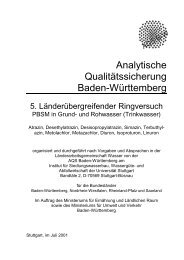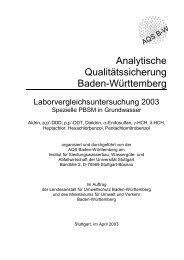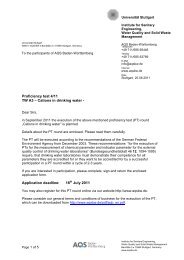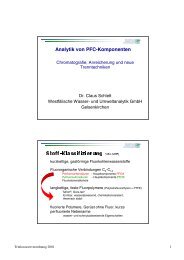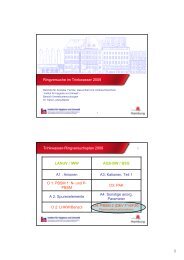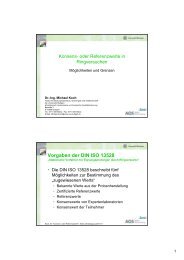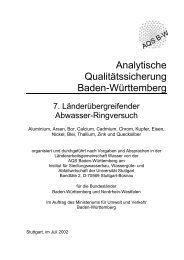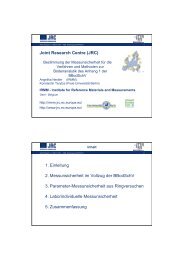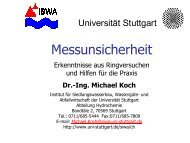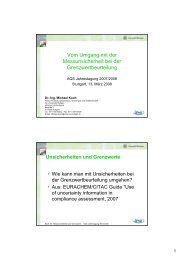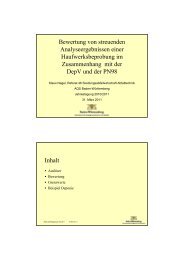Institute for Sanitary Engineering, Water Quality and Solid Waste ...
Institute for Sanitary Engineering, Water Quality and Solid Waste ...
Institute for Sanitary Engineering, Water Quality and Solid Waste ...
Create successful ePaper yourself
Turn your PDF publications into a flip-book with our unique Google optimized e-Paper software.
<strong>Water</strong> <strong>Quality</strong> Management <strong>and</strong> <strong>Water</strong> Supply WGW<br />
Financing Institution:<br />
Federal Ministry of Education <strong>and</strong> Research<br />
Project Partner:<br />
Germany:<br />
Leibniz Universität Hannover<br />
Universität Passau<br />
Universität Kassel<br />
Humboldt-Universität Berlin<br />
Justus-Liebig-Universität Giessen<br />
Deutsches Institut für tropische und subtropische<br />
L<strong>and</strong>wirtschaft GmbH<br />
China:<br />
Xishuangbanna Tropical Botanical Garden, Chinese<br />
Academy of Science (CAS)<br />
China Agricultural University (CAU)<br />
Yunnan Agricultural University (YAU)<br />
Yunnan Academy of Social Sciences (YASS)<br />
Naban River <strong>Water</strong>shed National Nature Reserve<br />
Bureau (NRWNNRB)<br />
TianZi Biodiversity Research <strong>and</strong> Development<br />
Centre<br />
Project Manager:<br />
Prof. Dr.-Ing. Heidrun Steinmetz,<br />
Prof. Dr.-Ing. Silke Wieprecht<br />
Project Coordinator:<br />
Dipl.-Ing. Ralf Minke, AOR<br />
Contact:<br />
Dr. rer. nat. Bertram Kuch,<br />
Dipl.-Ing. Manuel Krauß,<br />
Dipl.-Ing. Qingfan Zhang<br />
A novel <strong>and</strong> cost-effective approach on preventive<br />
water pollution control<br />
An improvement of water pollution control in the municipal<br />
waste water practice is either achieved long<br />
term by process integrated in-plant measures in order<br />
to reduce the waste water quantity respectively improve<br />
the waste water quality or near-term by costintensive<br />
advanced treatment (end-of-pipe). The generally<br />
fluctuating water quality <strong>and</strong> quantity results in<br />
extremely varying dirt load peaks the treatment plant<br />
has to cope with, i.e. the waste water treatment plants<br />
rarely work in their optimal range. Temporarily either<br />
the compulsory limit values are exceeded resulting in<br />
potential water pollution or the waste water treatment<br />
plants capacity is not efficiently used. A solution to<br />
this problem can be integrated approach to the entire<br />
waste water system. Often free storage or treatment<br />
capacity is not detected or used.<br />
The objective of a case study of the University of<br />
Stuttgart, <strong>Institute</strong> of <strong>Sanitary</strong> <strong>Engineering</strong>, <strong>Water</strong><br />
<strong>Quality</strong> <strong>and</strong> <strong>Solid</strong> <strong>Waste</strong> Management, is to achieve<br />
a preventive water pollution control by setting up a<br />
sophisticated interaction of industrial indirect dischargers,<br />
municipal waste water treatment plant, sewage<br />
network <strong>and</strong> storm water treatment. The main idea<br />
is to establish a load controlled concept based both<br />
on online measurement <strong>and</strong> data from an integrated<br />
dynamic simulation model embracing the complete sewage<br />
system. A major task of the project is to design<br />
this simulation model.<br />
Scheme of optimised cooperation of indirect discharger, sewage network <strong>and</strong> waste water treatment plant<br />
55




